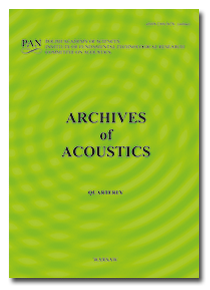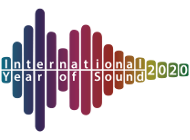10.24425/aoa.2022.140733
Pursuing Listeners’ Perceptual Response in Audio-Visual Interactions – Headphones vs Loudspeakers: A Case Study
References
Alais D., Burr D. (2004), The ventriloquist effect results from near-optimal bimodal integration, Current Biology, 14(3): 257–262, doi: 10.1016/j.cub. 2004.01.029.
Bernschütz B. (2013), A spherical far field HRIR/HRTF compilation of the Neumann Ku 100, [in:] Proceedings of the 39th DAGA, pp. 592–595, Meran, Italy.
Bertelson P. (1998), Starting from the Ventriloquist: The perception of multimodal event, [in:] Advances In Psychological Science, Vol. 2. Biological And Cognitive Aspects, Sabourin M., Craik F.I.M., Robert M. [Eds], pp. 419–439, Psychology Press/Erlbaum (UK) Taylor & Francis.
Bertelson P., Aschersleben G. (1998), Automatic visual bias of perceived auditory location, Psychonomic Bulletin & Review, 5: 482–489, doi: 10.3758/ bf03208826.
Bizley J.K., Maddox R.K., Lee A.K.C. (2016), Defining auditory-visual objects: behavioral tests and physiological mechanisms, Trends in Neurosciences, 39(2): 74–85, doi: 10.1016/j.tins.2015.12.007.
Blauert J., Braasch J. [Eds] (2020), The Technology of Binaural Understanding, Springer International Publishing, doi: 10.1007/978-3-030-00386-9.
Chiou R., Rich A.N. (2012), Cross-modality correspondence between pitch and spatial location modulates attentional orienting, Perception, 41(3): 339–353, doi: 10.1068/p7161.
Ecker A.J., Heller L.M. (2005), Auditory – visual interactions in the perception of a ball’s path, Perception, 34(1): 59–75, doi: 10.1068/p5368.
Frissen I., Vroomen J., De Gelder B., Bertelson P. (2004), The aftereffects of ventriloquism: generalization across sound-frequencies, Acta Psychologica, 118(1–2): 93–100, doi: 10.1016/j.actpsy.2004.10.004.
Gardner M.B. (1968), Proximity image effect in sound localization, The Journal of the Acoustical Society of America, 43(1): 163, doi: 10.1121/1.1910747.
Hampel F.R. (1974), The influence curve and its role in robust estimation, Journal of the American Statistical Association, 69(346): 382–393, doi: 10.2307/ 2285666.
Hendrickx E., Paquier M., Koehl V. (2015), Audiovisual spatial coherence for 2D and stereoscopic3D movies, Journal of the Audio Engineering Society, 63(11):889–899, doi: 10.17743/jaes.2015.77.
IEM Plug-In Suite (n.d.), https://plugins.iem.at/.
Ildirar S., Levin D.T., Schwan S., Smith T.J. (2017), Audio facilitates the perception of cinematic continuity by first-time viewers, Perception, 47(3): 276–295, doi: 10.1177/0301006617745782.
Iravantchi Y., Goel M., Harrison C. (2020), Digital ventriloquism: giving voice to everyday objects, [in:] Proceedings of the 2020 CHI Conference on Human Factors in Computing Systems, doi: 10.1145/ 3313831.3376503.
Kohlrausch A., Par S. van de (2005), Audiovisual interaction in the context of multi-media applications, [in:] Communication Acoustics, Blauert J. [Ed.], pp. 109–138, Springer, Berlin, Heidelberg, doi: 10.1007/3-540-27437-5_5.
Komiyama S. (1989), Subjective evaluation of angular displacement between picture and sound directions for HDTV sound systems, Journal of the Audio Engineering Society, 37(4): 210–214, http://www.aes.org/ e-lib/browse.cfm?elib=6094.
Kunka B., Kostek B. (2012), Objectivization of audio-visual correlation analysis, Archives of Acoustics, 37(1): 63–72, doi: /10.2478/V10168-012-0009-4.
Kunka B., Kostek B. (2013), New aspects of virtual sound source localization research–impact of visual angle and 3-D video content on sound perception, Journal of the Audio Engineering Society, 61(5): 280–289, http://www.aes.org/e-lib/browse.cfm?elib=16824.
Morein-Zamir S., Soto-Faraco S., Kingstone A. (2003), Auditory capture of vision: examining temporal ventriloquism, Cognitive Brain Research, 17(1): 154– 163, doi: 10.1016/s0926-6410(03)00089-2.
Munn S.M., Pelz J.B. (2008), 3D point-of-regard, position and head orientation from a portable monocular video-based eye tracker, [in:] Proceedings of the Eye Tracking Research & Application Symposium, ETRA 2008, pp. 181–188, Savannah, Georgia, USA, doi: 10.1145/1344471.1344517.
Pike C., Stenzel H. (2017), Direct and indirect listening test methods – a discussion based on audio-visual spatial coherence experiments, [in:] 143rd Audio Engineering Society Convention, New York, USA.
Pruchnicki P., Plaskota P. (2008), Automatic measuring system for head-related transfer function measurement, Archives of Acoustics, 33(1): 19–25.
Radeau M., Bertelson P. (1977), Adaptation to auditory-visual discordance and ventriloquism in semirealistic situations, Perception & Psychophysics, 22(2): 137–146, doi: 10.3758/bf03198746.
Ramos O.A., Tommasini F.C. (2014), Magnitude modelling of HRTF using principal component analysis applied to complex values, Archives of Acoustics, 39(4): 477–482, doi: 10.2478/aoa-2014-0051.
Regan D., Spekreijse H. (1977), Auditory-visual interactions and the correspondence between perceived auditory space and perceived visual space, Perception, 6(2): 133–138, doi: 10.1068/p060133.
Romanov M., Berghold P., Frank M., Rudrich D., Zaunschirm M., Zotter F. (2017), Implementation and evaluation of a low-cost headtracker for binaural synthesis, [in:] 142nd Audio Engineering Society Convention, Berlin, Germany.
Sorati M., Behne D.M. (2021), Considerations in audio-visual interaction models: an ERP study of music perception by musicians and non-musicians, Frontiers in Psychology, 11: 33551911, doi: 10.3389/fpsyg.2020.594434.
Stenzel H., Francombe J., Jackson P.J.B. (2019), Limits of perceived audio-visual spatial coherence as defined by reaction time measurements, Frontiers in Neuroscience, 13: 451, doi: 10.3389/fnins.2019.00451.
Stenzel H., Jackson P.J.B. (2018), Perceptual thresholds of audio-visual spatial coherence for a variety of audio-visual objects, [in:] Audio Engineering Society International Conference on Audio for Virtual and Augmented Reality, Redmond, WA, USA.
Stenzel H., Jackson P.J.B., Francombe J. (2017), Modeling horizontal audio-visual coherence with the psychometric function, [in:] 142nd Audio Engineering Society Convention, Berlin, Germany.
Storek D., Rund F., Marsalek P. (2016), Subjective evaluation of three headphone-based virtual sound source positioning methods including differential headrelated transfer function, Archives of Acoustics, 41(3): 437–447, doi: 10.1515/aoa-2016-0043.
Vorländer M. (2014), Virtual acoustics, Archives of Acoustics, 39(3): 307–318, doi: 10.2478/aoa-2014-0036.
Vorländer M. (2020), Auralization. Fundamentals of Acoustics, Modelling, Simulation, Algorithms and Acoustic Virtual Reality, Springer International Publishing, doi: 10.1007/978-3-030-51202-6.
Vroomen J., Bertelson P., De Gelder B. (2001), The ventriloquist effect does not depend on the direction of automatic visual attention, Perception & Psychophysics, 63(4): 651–659, doi: 10.3758/bf03194427.
Vroomen J., De Gelder B. (2004), Perceptual effects of cross-modal stimulation: ventriloquism and the freezing phenomenon, [in:] Handbook of Multisensory Processes, Calvert G.A., Spence C., Stein B.E. [Eds], pp. 141–150, MIT Press.
Walker L., Walker P., Francis B. (2012), A common scheme for cross-sensory correspondences across stimulus domains, Perception, 41(10): 1186–1192, doi: 10.1068/p7149.
Woodcock J., Davies W.J., Cox T.J. (2019), Influence of visual stimuli on perceptual attributes of spatial audio, Journal of the Audio Engineering Society, 67(7/8): 557–567, doi: 10.17743/jaes.2019.0019.
Yao S.-N., Collins T., Liang C. (2017), Head-related transfer function selection using neural networks, Archives of Acoustics, 42(3): 55–62, doi: 10.2478/aoa2013-0007.
Zaunschirm M., Schoerkhuber C., Hoeldrich R. (2018), Binaural rendering of Ambisonic signals by head-related impulse response time alignment and a diffuseness constraint, The Journal of the Acoustical Society of America, 143(6): 3616, doi: 10.1121/1.504 0489.
Zotter F., Frank M. (2019), Ambisonics. A Practical 3D Audio Theory for Recording, Studio Production, Sound Reinforcement, and Virtual Reality, Springer International Publishing, pp. 89–90, doi: 10.1007/978-3030-17207-7.
DOI: 10.24425/aoa.2022.140733






